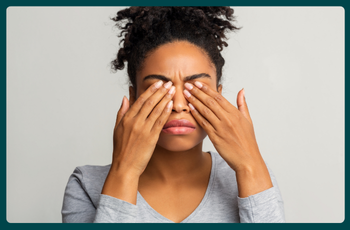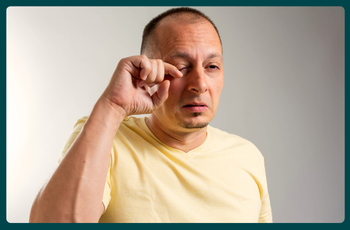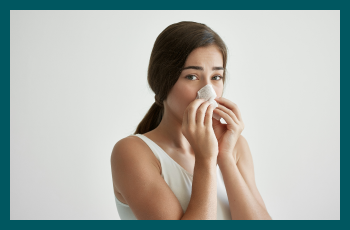What is a dust mite allergy?
Dust mite allergy is a prevalent allergic reaction to tiny bugs in household dust. These microorganisms, known as dust mites, grow abundantly in warm, muggy atmospheres, particularly in bedding, mattresses, carpets, curtains, and upholstered furniture. They consume skin flakes shed by humans and animals. The proteins in their faeces and bodily residues may provoke allergic reactions in hypersensitive individuals. The most common type of dust mite found in Australian homes is Dermatophagoides pteronyssinus associated with dermatological and respiratory allergies in humans such as asthma and eczema.How does a dust mite allergy affect my body?
A dust mite allergy affects the body largely through allergic responses caused by contact with dust mite faeces and body components.- Sneezing, a runny or stuffy nose, itching, and post-nasal drip are all common symptoms caused by nasal channel irritation.
- For asthmatic patients, exposure might exacerbate symptoms such as wheezing and chest tightness. Eczema and other skin responses are possible, especially in youngsters.
- Eyes might get inflamed, causing redness, itching, and wetness.
- Prolonged exposure may lead to chronic sinusitis, resulting in persistent nasal congestion and pain.
- Dust mite allergies can be managed by allergen avoidance (using allergen-proof bedding and frequent cleaning), drugs (antihistamines, nasal corticosteroids), and, in certain cases, allergen immunotherapy.
Symptoms and causes
Symptoms: Symptoms of dust mite allergies include sneezing, runny or stuffy nose, itching (particularly in the eyes, nose, or roof of the mouth), post-nasal drip, coughing, face pressure or discomfort. Dust mites may also aggravate asthma symptoms, such as wheezing, shortness of breath, chest tightness, and coughing.Causes: Dust mite allergies occur when the immune system reacts to proteins in dust mite faeces and body components. These tiny organisms thrive in warm, humid habitats such as bedding, upholstered furniture, and carpeting. Dust mites consume dead skin cells produced by humans and pets, and their waste particles become airborne when disturbed. When breathed or encountered by sensitive individuals, these allergens can cause an allergic response. Both genetic and environmental factors can cause dust mite allergies. Allergic-proof bedding, regular cleaning, low humidity levels, and air filtration devices can all assist in reducing exposure and managing symptoms.
How to stop dust mite allergy?
To properly manage and minimise dust mite allergies, you may utilise the following strategies:- Use allergen-proof bedding: Wrap pillows, mattresses, and box springs with allergen-proof coverings impenetrable to dust mites and allergens.
- Wash bedding frequently: To kill dust mites and eliminate allergies, wash sheets, pillows, and blankets at least once a week in hot water (at least 130°F or 54°C).
- Reduce humidity: Keep humidity levels below 50% to prevent dust mite growth. Use a dehumidifier as needed, particularly in humid locations or during humid weather.
- Choose wise flooring: Instead of carpeting, which might harbour dust mites, choose hard flooring (wood, tile, or linoleum). If you have carpeting, steam clean it regularly.
- Reduce clutter: Remove objects that attract dust, such as soft toys, knickknacks, and books on open shelves.
- Avoid soft furnishings: Limit soft furnishings by using washable curtains and shutters instead of heavy drapes. Choose upholstered furniture with smooth surfaces that are easy to maintain.
- Air filtration: To capture dust mite allergens, use a high-efficiency particulate air (HEPA) filter in your home's HVAC system or a standalone air purifier.
- Medications and immunotherapy: Consult an allergist or immunologist about symptom-management drugs such as antihistamines or nasal corticosteroids. Allergen immunotherapy (allergy injections) may be used for severe allergies to gradually desensitise the immune system.
- Pet care: Keep pets out of bedrooms and away from upholstered furniture to prevent exposure to pet fur, which attracts dust mites.
- Indoor plants: Soil may contain mould spores, which can aggravate dust mite allergies. Minimise the number of indoor plants and keep an eye on mould growth.
- Seal cracks and gaps: Sealing cracks and gaps around windows, doors, and other entry points will keep dust and external allergens out of your home.
- Frequent dusting: Dusting surfaces in your home regularly using a moist cloth or microfiber cloth will capture and eliminate dust mites and associated allergies.
When should I consult a doctor?
If you continue to be afflicted with chronic or severe dust mite allergy symptoms after implementing home management techniques, you should see a doctor. Signs to look out for include frequent sneezing, nasal congestion, trouble breathing, persistent coughing, wheezing, or skin responses such as eczema. Furthermore, if dust mite allergies seriously impair your daily activities, sleep, or quality of life, seek medical attention. A doctor can help to diagnose your allergies, prescribe suitable medications, and, if necessary, recommend allergen immunotherapy. They can also advise you on how to properly manage your illness. To speak to a registered health practitioner from home in minutes, book a telehealth appointment.Can a telehealth doctor help?
Yes, a telehealth doctor can successfully help with dust mite allergy management. Through virtual consultations, healthcare providers can evaluate symptoms, discuss medical records, and offer tailored advice on allergy management strategies. They can prescribe medications or recommend tests depending on the severity of the allergy. Telehealth also guides environment-controlling measures such as regular cleaning and humidity control techniques to minimise dust mite exposure. Patients can receive complete advice on symptom relief and long-term management strategies from the comfort of their homes.So, as we come to the end of our exploration of dust mite allergy, we should remember that knowledge is the most valuable tool in this ongoing battle. By understanding the triggers and adopting practical strategies like regular cleaning, we can mitigate the effects of dust mites in our lives. Let’s work towards a healthier ecosystem and more radiant tomorrow, where allergies no longer disrupt our comfort and well-being.

Consult an Online Doctor in 15 mins




Reference
- Dust mites - reference link
- House dust mite - reference link






 Facebook
Facebook Instagram
Instagram LinkedIn
LinkedIn



